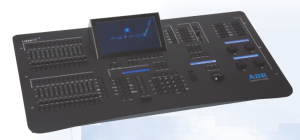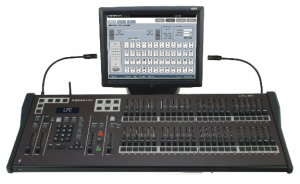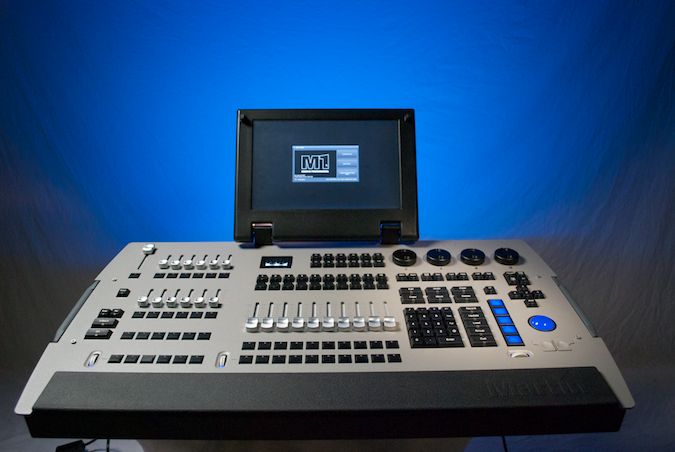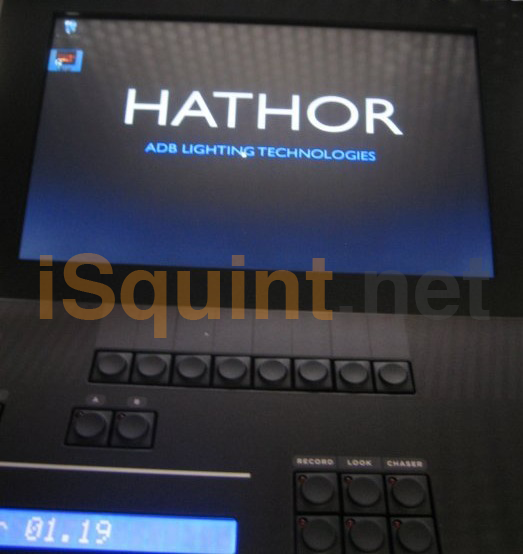ADB Lighting Set To Release LIBERTY & FREEDOM Control Desks
 ADB Lighting will unveil at Prolight+Sound, Frankfurt a. M., Germany (Hall 9.0 Stand C50) LIBERTY and FREEDOM, two advanced lighting control desks, based on the very powerful HATHOR software platform previewed earlier this year. These two desks are unique in the sense they have been specifically designed for theatre stage lighting, without any compromise to cover other applications, as it is often the case with so called multipurpose consoles.
ADB Lighting will unveil at Prolight+Sound, Frankfurt a. M., Germany (Hall 9.0 Stand C50) LIBERTY and FREEDOM, two advanced lighting control desks, based on the very powerful HATHOR software platform previewed earlier this year. These two desks are unique in the sense they have been specifically designed for theatre stage lighting, without any compromise to cover other applications, as it is often the case with so called multipurpose consoles.
LIBERTY is the spot-on solution for space-challenging environments and any cost-conscious venue seeking a fully integrated solution to control conventional and moving lights as well as LED sources and other modern equipment in a compact and portable package with the capacity of much larger and more expensive lighting consoles.
FREEDOM offers the ideal solution when more multi-parameter instruments need to be controlled and fast access is required. The desk allows users to control large quantities of multiple LED fittings, intelligent lights or media servers as well as standard generic dimming systems. Features includes four additional rotary wheels with push button function, a set of special keys to manipulate moving lights, and a super smooth, large size trackball for precision positioning control.
Learn more about the ADB Lighting LIBERTY & FREEDOM Desks by visiting their website at www.adblighting.com.
Leprecon to Update LPC Console with Moving Light Controls
 Last year at LDI, Leprecon introduced the LPC series of lighting desk. This year, they are planning to make an announcement about the software update to the LPC series with moving lighting controls built in.
Last year at LDI, Leprecon introduced the LPC series of lighting desk. This year, they are planning to make an announcement about the software update to the LPC series with moving lighting controls built in.
The LPC is on the “low tech” end of the console spectrum with the ability to handle 2 universes of DMX and 512 control channels. From what I have heard and seen about the console, it is pretty flexible for it’s price point at just under $6,000 USD for the LPC-48V and $7,600 for the LPC-96V both provided with a touch screen.
The desk is designed for the HOW, community theatre, high school, middle school markets but are defiantly not limited to those. I have got to get behind the new software/desk and give it a test drive!
Learn more about the Leprecon LPC Series of console by visiting www.leprecon.com.
Review: Martin M1 Lighting Desk

At ProLight + Sound this year, Martin Professional announced to the world their latest control product, the M1 Lighting Desk. Martin is boasting the M1 as the next generation of Lighting control in the lighting industry. With the form and function of the M1, it is pretty clear why they say that.
The M1 is a compact, portable and feature rich lighting desk compared to Martin’s other control desk options, the Maxxyz series of desks. There are numerous options and configurations available in the Maxxyz line up of desks, but nothing as affordable, lightweight and ready out of the box like the M1.
From the design and features built into the M1, I feel that Martin targeted the M1 to a specific portion of the market, the smaller touring market. At just under 32lbs., in a metal housing, the M1 is not only built tough, but looks tough. With it’s solid construction, the M1 should have no troubles handling anything a life on the road will throw at it.
[singlepic id=1101 w=320 h=240 float=left]On the surface of the M1, there is control coming at you where ever you look at the desk. The M1 has plenty of sliders, executors and paging wheels to make your head spin at first glance. Off to the far left, you have your theatrical style main playback. Just off to the right of the main playback are twelve single sliders with a function assignable button and twelve more single assignable buttons just below that. This is the first of two section of play backs. In the second section there are 10 playback faders, each with four function assignable functions right dead center of the desk for easy execution. No matter where your hands fall on the desk or what type of playback you might need, you’ll never be to far away from a playback.
If you did the math quick enough, that means that there are only thirty four places on the M1 to assign something for a playback. Don’t forget about the paging wheels. The ten center playbacks and the twenty four playbacks to the right have their own paging wheel to access even more playback underneath, up to 100 pages.
The M1 makes available 1000 cuelist which can be assigned to sliders with fade control or playbacks with control buttons. On top of those 1000 cuelist, you have the ability to add as many cues as you like with no restriction based on cue count. Just a bit of playback space no?
To help make the M1 even more lightweight and portable, Martin included a fold up 13” touch screen. No more worrying about if the monitors made it to the show, it’s built into the desk.
[singlepic id=1106 w=320 h=240 float=left]At the time of the review, the M1’s software was still in beta and wasn’t able to run a second monitor for more heads up display. Martin has already fixed this issue and updated the software to were the display port on the back of the M1 offers the ability to add a second monitor which also support ELO USD touch screens.
Under the hood of the M1 is an industrial motherboard with an dual core Intel Processor, integrated graphics all in a modular construction for easy repairs and replacement if something should ever go wrong. The M1 also features a 2.5” SATA hard drive at eighty gigs in size which is more then plenty to run the OS and save plenty of backups to your shows.
Speaking of Operating Systems, the M1 works off an industrial version of Windows XP embedded. Before the end of 2010, Martin is expecting to upgrade to Windows 7 embedded giving the M1 the power and performance of Windows 7. This will be a free software update from Martin. Now I tried my hardest, it was impossible to “break into” the Windows side of the desk, meaning Martin has locked down the core OS pretty well. Since the desk is based on Windows, saving and opening shows off of a USB jump drive is just as simple as on a PC.
[singlepic id=1105 w=320 h=240 float=left]Control on the M1 should never become an issue. Starting off with four universes of DMX right off the bat, smaller shows should have no problem controlling any small to medium sized moving rig. As time goes on, adding fixtures to any rig might cause a hiccup in control as those four universes of DMX quickly become filled. Not a problem with the M1. As your rig grows so can the M1’s universe count. While the M1 starts off with only 4 universes, you can add universes to the desk via universe licenses, up to 12 total via networking and Artnet.
For most of us, 6,144 parameters of DMX might be a bit much for our needs, but as time goes by and your rig keeps growing, you might out grow the M1. In the distant future when that time comes, you may have to upgrade to one of Martins Maxxyx line up of consoles. The best part is, you will not have to learn an new programing syntax! The M1 is the same programing syntax as Martin’s Maxxyz consoles. In fact, it is the same operating system! Now, if you are already a Maxxyz programmer, perfect, you already know the M1.
The M1 is based on the Maxxyz, layout and function of the desks are exactly alike. The M1 utilizes programmer and playback state of the console. The programmer side being where we enter the changes we like and then store them into some sort of playback whether that be a cue or submaster. The playback side of the desk is just as it sounds where these cue list, cues, effect, whatever you like to call them are, you guessed it played back.
Now if you feel that you need additional playback sliders at your finger tips and thirty four is just not enough, why not add a Max Module Playback, Button or Submaster Module? Since the M1 is based on the Maxxyz Console, the desk is easily expandable to your needs with addition sliders, executor buttons or submasters.
[singlepic id=292 w=320 h=240 float=left]You can even connect the M1 to a wireless access point and wirelessly connect an iPad, iPhone or iPod touch and run the free app from Martin, the MaxRemote. Just like any console remote like the MaxRemote, you have to have a little bit of network savviness to connect everything correctly. As a lighting professional in the digital age, this type of responsibility is required and demanded of us more and more.
After setting everything up correctly on the network, and on the iPad/iPhone/iPod Touch, using the MaxRemote to focus, program and run a show is fairly easy and straight forward after learning the Maxxyz syntax. The MaxRemote is a useful tool when connected to the M1 to fine tune focus points while on stage and away from the desk.
Overall, the M1 is a rugged, well designed and laid out touring desk. It has power behind it that can control almost any medium sized rig with no problem and has the ability to grow with your rig. I feel that the M1 was designed to be a busking desk and it shows with the amount of playbacks offered on the surface. It also offers the ability to playback as a traditional theatrical style desk making it very flexible. The M1 can be used in a wide variety of venues from traditional theatre, live performance, corporate events, the list can go on and on.
Don’t believe me, the M1 has already seen some action on some larger shows such as the World Cup. Not a bad start for a new console making it’s way to primetime in less then six months. I expect to see and hear about the M1 on many more shows and events of this size. You can follow the M1’s adventure on Facebook. You can also see the M1 up close and personal on the Martin Roadshow which is touring around the country this summer.
To learn more about the Martin M1 Lighting Desk, visit www.martin.com. Hve you had a chance to work on the Martin M1 Desk? What do you think? I would love to hear your comments about the desk and of course, this review.
[nggallery id=61]
Update: ADB Lighting HATHOR Desk PHOTO

I got a lovely little surprise in my inbox after coming back from lunch. Looks like a reader has seen the HATHOR console or possibly knows some one at ADB lighting to be sending this along. What can we tell from this photo? It seems as though the codenamed HATHOR desk coming from ADB Lighting has at least one integrated touchscreen and has the ability to record, look and chaser. All good qualities of a desk! What else… not much, what do you think?
I guess we’ll just have to wait till next week at ProLight + Sound to see more of the desk.
Avolites Introduces Tiger Touch Lighting Console
 During LDI 2009, I got a chance to stop by and take a close look at Avolites latest lighting desk, the Tiger Touch. The Tiger Touch is a “hybrid” of the of powerful Diamond 4 functionality coupled with the friendly Pearl interface. The desk features a wide screen touch interface that provides an ever evolving software skin which can be adapted to the programmers style and layout preferences.
During LDI 2009, I got a chance to stop by and take a close look at Avolites latest lighting desk, the Tiger Touch. The Tiger Touch is a “hybrid” of the of powerful Diamond 4 functionality coupled with the friendly Pearl interface. The desk features a wide screen touch interface that provides an ever evolving software skin which can be adapted to the programmers style and layout preferences.
The Tiger Touch Lighting Desk utilizes Avolites latest Operating System, the TITAN. TITAN has been created as a “Clean Sheet”. It’s fresh, clear design is fast and elegant to use. Avolites will continue to develop the TITAN Operating System and these benefits are continuously offered to users ongoingly at no extra charge under Avolites policy of “Free Upgrades for the Life of the Console”.
Some of the features included in the Tiger Touch and the TITAN OS:
- Fixture Exchange
- Fixture Copy
- Attribute Timing on Cues
- Head Up Display with Visualizer
- iPhone/iPod Touch Remote Control
The Tiger Touch Lighting Desk offer 4 universes of DMX out directly o the board with the ability to speak Art-Net nativily over Ethernet and up to 12 universe of DMX. The Tiger Touch seems to be a great tour console with the 4universes of output giving us 2,048 addresss to play with plenty of conventionals and moving lights. With it’s small form factor, just 29.5″ x 24″ x 12″ and weighing in at 66lbs in a flight case, the Tiger Touch Lighting Desk might be an option. I am still waiting to hear on price as the desk has not begun to ship yet through TMB, the US distributor.
For more information on the Tiger Touch Lighting Desk from Avolites, visit their website at www.avolites.org.uk.
LatestHeadlines
- Upgrading Your Toolbox: City Theatrical DMXcat-E and DMXcat Multi Function Test Tool
- Claypaky Bringing Back the Sexy to Par Cans with the Midi-B FX
- Ayrton Evolves the Cobra, the Cobra2 Developed for the US Market
- MA Lighting Intros grandMA3 onPC Fader Wing and DIN-Rail Nodes
- Live Events LEVL Up Fest: A Festival to Aid our Industry